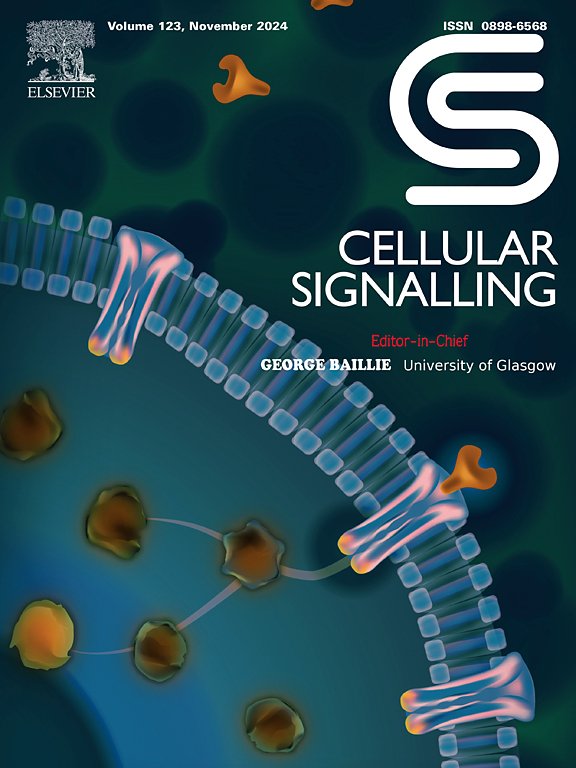E3泛素连接酶的高通量筛选发现TRIM48是RIG-I信号传导的一种新的负调节因子
IF 3.7
2区 生物学
Q2 CELL BIOLOGY
引用次数: 0
摘要
视黄酸诱导基因i (RIG-I)信号对细胞固有的先天抗病毒免疫至关重要。在细胞质检测到病毒相关RNA后,它触发级联诱导产生有效的细胞因子,主要是I型和III型干扰素(ifn)。虽然有效,但失调的反应会损害宿主,需要严格的通路控制。在这里,我们对616种已建立和推测的E3泛素连接酶进行了全面、系统的基于sirna的高通量筛选,以研究它们对RIG-I信号传导的影响。我们在A549细胞中采用基于荧光的活细胞成像实验来监测IRF3和NF-κB的核易位,这是RIG-I下游的两个关键转录因子。候选基因在正交二次筛选中验证,评估它们对裂谷热报告病毒功能性抗病毒反应的影响。14次点击在两个屏幕上显示了对rig - 1信号的一致影响。这些基因在dsRNA转染后通过评估IFN-β启动子报告活性和IFNB1 mRNA水平进一步验证和表征。TRIM48作为一种高度稳健的负调节因子出现。TRIM48的过表达抑制rig - i介导的IRF3和NF-κB的激活,降低IFN和IFN刺激的基因表达,增强病毒复制。相反,TRIM48缺陷增强RIG-I信号传导并抑制病毒复制。值得注意的是,TRIM48对感染起诱导反馈调节作用,其作用取决于其酶泛素连接酶活性。我们的高通量筛选为接近所有E3泛素连接酶在RIG-I信号传导中的调节作用提供了公正的评估,并确定了几个有趣的候选者,供进一步研究。TRIM48被确定为RIG-I通路的负反馈调节因子。本文章由计算机程序翻译,如有差异,请以英文原文为准。
High-throughput screening of E3 ubiquitin ligases identifies TRIM48 as a novel negative regulator of RIG-I signaling
The retinoic acid-inducible gene-I (RIG-I) signaling is crucial for cell-intrinsic innate antiviral immunity. Upon cytosolic detection of virus-associated RNA, it triggers a cascade inducing production of potent cytokines, mainly type I and III interferons (IFNs). While effective, dysregulated responses can harm the host, requiring tight pathway control. Here, we performed a comprehensive, systematic siRNA-based high-throughput screen across 616 established and putative E3 ubiquitin ligases for their impact on RIG-I signaling. We employed a fluorescence-based live-cell imaging assay in A549 cells to monitor nuclear translocation of IRF3 and NF-κB, two key transcription factors downstream of RIG-I. Candidate genes were validated in an orthogonal secondary screen, assessing their impact on the functional antiviral response to a Rift Valley Fever reporter virus. Fourteen hits showed consistent effects on RIG-I signaling across both screens. These genes were further validated and characterized by assessing IFN-β promoter reporter activity and IFNB1 mRNA levels upon dsRNA transfection. TRIM48 emerged as a highly robust negative regulator. Overexpression of TRIM48 suppressed RIG-I-mediated activation of IRF3 and NF-κB, reduced IFN and IFN-stimulated gene expression, and enhanced viral replication. Conversely, TRIM48 deficiency enhanced RIG-I signaling and inhibited viral replication. Notably, TRIM48 acts as an induced feedback regulator upon infection, and its effect depended on its enzymatic ubiquitin ligase activity. Our high-throughput screen provides an unbiased assessment of close to all E3 ubiquitin ligases for their regulatory effect in RIG-I signaling, and identified several interesting candidates for further investigation. TRIM48 was established as a negative feedback regulator of the RIG-I pathway.
求助全文
通过发布文献求助,成功后即可免费获取论文全文。
去求助
来源期刊

Cellular signalling
生物-细胞生物学
CiteScore
8.40
自引率
0.00%
发文量
250
审稿时长
27 days
期刊介绍:
Cellular Signalling publishes original research describing fundamental and clinical findings on the mechanisms, actions and structural components of cellular signalling systems in vitro and in vivo.
Cellular Signalling aims at full length research papers defining signalling systems ranging from microorganisms to cells, tissues and higher organisms.
 求助内容:
求助内容: 应助结果提醒方式:
应助结果提醒方式:


